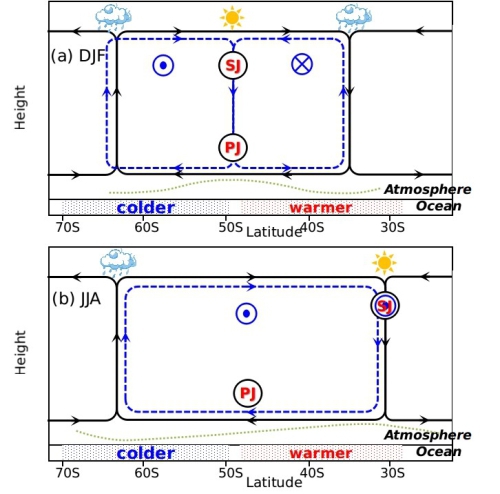In the Southern Hemisphere (SH) extratropical ocean encircling the Antarctic, the annual mean sea surface temperature (SST) is about 0°C–15°C. Compared with the tropical ocean, characterized by an annual mean SST of around 16°C–29°C, it is a relatively cold ocean. SST anomalies (SSTAs) arising in the warmer tropical ocean can modulate atmospheric circulation via the triggering of atmospheric convection, but do those in the “cold” SH extratropical ocean also influence atmospheric circulation?
Associate Professor ZHENG Fei, from the Institute of Atmospheric Physics, Chinese Academy of Sciences, and her coauthors, explored the spatial and temporal characteristics of SH extratropical SST variability. The dominant mode of SH extratropical SST exhibits itself as a dipole-like structure. That is, when the middle-latitude (40°S) SST is warmer, the high-latitude (60°S) SST tends to be cooler. This dipole-like structure is referred to as the Southern Ocean Dipole (SOD). Details can be found in their paper published in Advances in Atmospheric Sciences on May 18, 2018.

Schematic representation of the responses of the Southern Hemisphere extratropical zonal mean circulation to the Southern Ocean Dipole–like SSTA during (a) December–February and (b) June–August. The black lines represent the climatological meridional circulation. The blue dashed lines represent the Southern Ocean Dipole–related meridional circulation anomalies. SJ and PJ represent the subtropical jet and polar jet, respectively. (Image by ZHENG Fei)
Atmospheric general circulation model (AGCM) simulations forced by SSTAs constitute an important tool to understand the influence of SST on the atmosphere. Thus, the team further examined the outputs from 28 AGCMs. The results showed that the SOD plays an important role in influencing atmospheric circulation, and the influence exhibits seasonal differences. During austral summer (December–February), the SSTAs related to the SOD lead to a meridional shift of the subtropical and polar jets, whereas during austral winter (June–August) the responses of the two jets manifest mainly in changes in strength. ZHENG explains the team’s findings:
"During austral summer, the Southern Hemisphere subtropical jet and polar jet merge into one jet, whereas during austral winter the two jets split from one another. The seasonal differences in the influence of the Southern Ocean Dipole on atmospheric circulation is related to the different configurations of the Southern Hemisphere jets in winter and summer”.
ZHENG further explains that the above results provide new evidence for the feedback of SH extratropical SST to the atmosphere.
Reference
Zheng, F., J. P. Li, F. Kucharski, R. Q. Ding, and T. Liu, 2018: Dominant SST mode in the Southern Hemisphere extratropics and its influence on atmospheric circulation. Adv. Atmos. Sci., 35(7), https://doi.org/10.1007/s00376-017-7162-7 .
